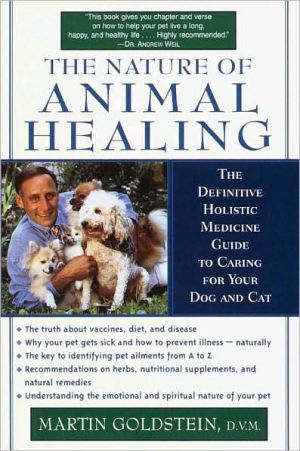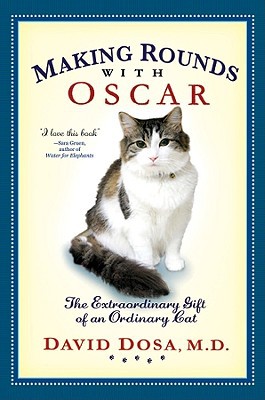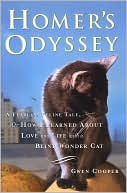The Nature of Animal Healing: The Definitive Holistic Medicine Guide to Caring for Your Dog and Cat
A pioneering revolutionary prescription for the health and long life of your pets\ For two decades, Dr. Martin Goldstein--America's most successful, renowned holistic veterinarian--has healed and helped his animal patients with the same natural therapies that benefit humans. The results have been so astounding that today critically sick pets are brought to him from across the country for a new chance at life and health.\ In this compelling, very accessible book, Dr. Goldstein explains exactly...
Search in google:
A pioneering revolutionary prescriptionfor the health and long life of your petsFor two decades, Dr. Martin Goldstein--America's most successful, renowned holistic veterinarian--has healed and helped his animal patients with the same natural therapies that benefit humans. The results have been so astounding that today critically sick pets are brought to him from across the country for a new chance at life and health.In this compelling, very accessible book, Dr. Goldstein explains exactly what holistic medicine is and how it works. By treating the root of a health problem instead of its symptoms, you too can help your animal to regain and maintain its own health, as nature intended. Dr. Goldstein also shares many remarkable true stories of supposedly terminally ill animals who have recovered to full wellness. Inside you'll discover- Why our animals get sick, even when we strive to give them the best of care- An exhaustive A to Z guide of pet ailments--and the best course of action- Why vaccines can do more harm than good- The link between diet and disease--and how the right diet can not only prevent disease but reverse it- How acupuncture, homeopathy, chiropractic, and other alternative options work--safely and painlessly--to restore true health- Specific guidance for the use of herbs, supplements, and natural remedies- The good news (and the bad) about cancer in animals--including extraordinary new treatments and potential cures- Coping with the inevitable death of your pet--both physically and psychologicallyAnd much, much morePLUS--the ultimate resource for holistic pet care: an extensive guide to holistic productmanufacturers and stores, books, newsletters, Web sites, veterinarians, and associations!
If animals could talk, here's what they'd say.\ For starters, about that food. Why, they'd ask, do you give me the same boring pet chow day after day? You don't have that kind of diet. You have different foods for every meal--and the foods you eat are real! Why wouldn't we want real food, too? Don't we have the same bodily needs? As it is, the dry kibble is boring, the canned food is gross, and neither kind seems to impart much nutrition. How, they'd ask, can a pet expect to feel peppy--never mind healthy--on that?\ Perhaps, they'd add, having thought long and hard on the subject, there's some connection between poor food and poor health. Certainly you take us to the vet more than ever before. Yet why, they'd ask, do visits to the clinic often leave us feeling worse in the long run? We come in with a skin inflammation, we're given a steroid; for a while we feel better, but then the effect fades. We go back with a fever, get an antibiotic; the fever goes down, but something else comes up. We get vaccines--five, six, seven ingredients at a time--meant to protect us against disease, yet days or even months later we feel sluggish and sick. Just as we're finally shaking off the ill effects, back we go to the vet for more.\ And if all that conventional medicine is supposed to keep us well, they'd ask, why are so many animals getting seriously sick? Why, in particular, is there so much cancer? Why are so many dying before their time?\ Pets don't talk to me either, but they don't need to. I see the results of bad diet and misguided conventional medicine every day. Admittedly, my clinic is somewhat different from the standard veterinary hospital. Like the doctors on ER, we take more than our share of desperate cases--basket cases, as some of my colleagues in the field put it. Though I certainly see healthy pets, many of the animals I treat have been given less than a month to live. They have some form of severe, premature degeneration: arthritis, kidney or liver failure, hyperthyroidism, or, most frequently, some form of cancer.\ If I were just seeing a small, steady trickle of extreme cases, year in, year out, you could stop reading right now. What, you could say, are the chances of your pet becoming one of those statistics? And if it did, that would just be fate, right? Bad luck out of the blue?\ Unfortunately, it's not that simple.\ Twenty-five years ago when I started out in practice, the pets I saw with these diseases were old. Their conditions seemed to be age-related, and slow-growing enough to be accepted. Of the cases I see now, many are young and don't live past the age of five. It's no longer unusual to see a three-year-old cat with kidney failure. Or an eighteen-month-old dog with part of its jaw eaten away by cancer.\ If the age of these patients is troubling, so too is the rate at which their diseases now grow. Not that long ago--in April 1997--I treated a seven-year-old Rottweiler named Wrinkles who had a huge, mushroom-shaped tumor next to her rectum; the tumor, a spindle cell sarcoma, had already grown back after being removed by a board-certified surgeon. I dug in, with my hands and instruments, four inches to grasp the extent of it and cut it out. Then I froze the remaining diseased cells with liquid nitrogen, destroying nearly 100 percent of her clinical cancer. Two weeks later, Wrinkles' owner called to report that the tumor had begun growing back, and was already the size of a walnut. That was on a Thursday. I asked the owner to bring her in on Monday to prepare her for another surgery. By then, the tumor was the size of a grapefruit. It was a case that even I, who rarely gives up on any pet, conceded was hopeless; I put her to sleep.\ Fortunately, we're able to save many of the pets we treat--to restore them to health, or at least to give them an extended period of happy life which they weren't expected to have. But the challenge grows as the conditions we see get more aggressive, more unpredictable, and more bizarre.\ The fact that we're now treating up to thirty-five new cases of cancer a week, far more than just a few years ago, is in a sense misrepresentative: cancer-stricken pets from all over the country are flown or driven in to us now, through clinic referrals or, increasingly, the Internet. But ask your local veterinarian if he's seen more cancer in recent years. Of course he has. A 1998 survey of disease-related death among pets by the nonprofit Morris Animal Foundation bears this out. Of 720 canine deaths reported, 479 were cancer-caused. The next highest category was heart-related problems (12 percent), followed by kidney (7 percent) and epilepsy (4 percent). Among 468 feline deaths, cancer also ranked highest (32 percent), followed by kidney and urinary disease (23 percent) and heart problems (9 percent). This raises the obvious questions: Why? And can anything be done about it?\ As a holistic veterinarian, I don't view cancer as a mysterious disease that attacks the body. It's the ultimate manifestation of ill health. It's what happens when the body's immune system, under siege for too long, at last surrenders, letting cell growth go awry. To me, it's clear that more and more pets are getting cancer and other degenerative diseases because they're being hit with more and more toxins that eventually mutate their genes, weakening successive generations.\ The assault begins with those processed and packaged foods: that most of us give our pets. Mediocre at best, they often contain toxins in their chemical additives and preservatives, or in reprocessed "meat" unfit for human consumption. Other toxins are absorbed from tap water or ground chemicals. A great number of cancer-producing toxins in pets come, I believe, from certain conventional drugs meant to improve their health. All this is accelerated, of course, by animals' relatively short life spans. Just in the time most of us have been alive, many generations of pets have come and gone. With each generation, the incidence of genetic diseases, including cancer, has increased.\ Cancer is the far marker, the defining outer limit of how toxic our world has become, and of what those toxins can do to animals. But almost every lesser manifestation of ill health is also aggravated by toxins that inhibit the immune system and keep an animal from healing itself. And all too often, when an animal desperately needs its toxins reduced, conventional medicine responds by adding more.\ Some years ago, a white terrier named Blake was brought into our clinic. At twenty-eight months of age, he had skin that was darkened, flaky, smelly, highly inflamed, and so itchy that he'd scratched off half his fur. He was truly suffering. We see a lot of patients with skin problems, by the way, and we see more of them now, in worse shape, than we did a decade ago. A conventional veterinarian had initially concluded--correctly--that Blake had severe allergies to such items as grasses, wool, fleas, and molds. Also, he had a secondary bacterial infection of the skin. The veterinarian had deduced that the rugs in the house contained the most immediate allergens tormenting Blake, and so the rugs had been removed. At the same time, Blake had been put on a series of different hypoallergenic diets. He'd also been subjected to a battery of desensitization injections after undergoing allergy testing, treatments with cortisone, antibiotics, and medicated shampoos, and finally even chemotherapy. When nothing worked, the veterinarian recommended having Blake put to sleep.\ First, we put Blake on dietary supplements, most of which were based on his individual deficiencies, determined by blood analysis. We also administered homeopathic remedies, initially by injection, then orally. We also gave him naturally derived injectable cortisone. As we did, we weaned him off all the prescription drugs he was on. Nine months later, Blake had perfect skin, his fluffy white coat had grown in fully, and he was a happy, healthy dog. My silent partner in Blake's revival? Blake. The dietary supplements gave him new strength, then Blake simply healed himself.\ The rugs, by the way, eventually went back into the house. They did contain allergens, but with Blake's immune system back in top shape, they didn't bother him at all.\ This is where holistic medicine begins: with the belief that the best way to cure an ill patient is to help him cure himself.\ "Cure" is a risky word to use--in our society, it implies a promise of eradication of symptoms for life. However, a reasonable state of cure, more appropriately known as remission, in which the patient's pain diminishes and his sense of well-being improves, is definitely and readily attainable when the patient is able to martial his own immune system to combat ill health. The body's immune system is the best defense, far better than man-made drugs. Keep it strong, restore it if it's weak, and the body, which is one amazing creation, will do almost whatever needs to be done to heal what's ailing it. When health has been restored, it can be maintained--if the immune system is sustained.\ Once, those words would have seemed naïve, if not blasphemous, to me. I didn't start out as a holistic veterinarian. I graduated in 1973 from Cornell University's College of Veterinary Medicine, considered by most in the field to be among the top-rated in the United States, and began my practice with as conservative an outlook on medicine as any of my colleagues. Little by little, out of curiosity, I began opening up, trying "new" alternatives that predated conventional medicine, from acupuncture to homeopathy, and finding, to my surprise and delight, that they worked. Today, at the Smith Ridge Center I oversee in South Salem, New York, we still apply conventional medicine when needed: from setting broken legs to administering the occasional direly needed antibiotic. But we find that 95 percent of the cases we take on can be treated alternatively. That includes healthy pets, whom we put on our special regimen of good food and dietary supplements to prevent their health from deteriorating. And it applies almost without exception to pets with common irritations--fleas, flaky skin, allergies, colitis--who are conventionally treated with drugs and chemicals that can do more harm than good. As for pets with extreme conditions whom we treat holistically, it's important to realize that we're not miracle workers: we don't save every one we treat. However, of the pets we do save, most have been deemed hopeless by veterinarians using conventional medicine.\ In the twenty-five years I've been in practice, a growing number of veterinarians have come to call themselves holistic. The American Holistic Veterinary Medical Association has seven hundred members, all veterinarians trained at conventional veterinary schools for the four years it takes to be licensed (after four years of undergraduate work). Just as it's becoming more and more accepted in the medical treatment of humans, so too has holistic treatment gained at least some credibility in helping animals. But it still isn't as commonplace as it could and should be.\ At Tufts, considered one of the most liberal veterinary school's, a group of some thirty holistically minded students had to lobby hard and long last year before being allowed to arrange a two-day, unaccredited seminar in acupuncture. At other schools, acupuncture simply doesn't exist as a course of treatment, much less one deserving of academic status. The result: Many graduating veterinarians remain ignorant of holistic approaches, and of the actual harm they're doing to animals by perpetuating certain conventional methods. Only by seeking out alternatives on their own can they begin to change the way they practice. But how many have the curiosity--let alone the time--to do that? And of those few who do, how many are willing to implement what they've learned?\ In the pages that follow, I'll explain how I approach different medical problems, and go into some detail on administering complementary products and preparations for disease and health states. I believe that this approach, and all it entails, will keep your pet healthier and happier, and prolong his life. But I don't mean for this to be a how-to book of holistic medicine that tells you, as a pet owner, all you need to know to be a do-it-yourself veterinarian. Those books exist for any who wish to find them; in my experience, as illuminating as they may be, they also lead to frustration. More times than I can count, an owner has brought in his obviously sick pet and rattled off a list of vitamins he's tried. His pet, however, is still sick. Our pets, like us, are all individuals, all with different requirements. So what works for one may not work for another. A young pet, for example, will often have an immune system far more capable of repelling a serious illness than that of an older pet. But sometimes a young pet is so genetically predisposed to immune deficiency that he will not respond as well as an older patient who has slowly built up his immune deficiency. Treatment for each should vary accordingly.\ My aim with this book is a more immediate one: to demonstrate the ways in which our pets are being ill served by us, by their environments, and, yes, by some aspects of conventional veterinary medicine. I hope to be, in effect, a voice for these pets, because they cannot talk. I want to show that with the right care, they can still lead healthy lives. And I intend to make clear that we are not the true healers of our pets; they are. The best we can do is to help them grow as strong as they can, both physically and emotionally, so that they can best tackle the hard work they must do to regain and maintain their own health.\ The fact is, with the right diet, a healthy kitten, puppy, or other young animal may not need any sort of veterinary care beyond annual checkups. I have three dogs of my own: Nina, a three-and-a-half-year-old Pomeranian; nine-month-old Kooper, also a Pomeranian; and Clayton, a four-year-old poodle. They have a proper, balanced diet of real food, nutritional supplements, and pure water. Aside from receiving an initial round of minimal vaccines, none of them has had to make the short trip to my office for professional care. The same holds true for my cats: Jasmine, a thirteen-year-old Siamese, The Geeter, a Maine coon, age twenty-three, and my new kitten, Squeeki. My pets almost never get treated, and their health is maintained exclusively through proper nutrition.\ For pets less fortunate than mine, who do have weakened immune systems that render them more vulnerable to disease, holistic veterinary medicine offers a rich, almost overwhelming array of treatments and possibilities. Underlying all, I've realized after practicing them for so long, is a series of fundamental principles that are the root of all we know and practice in holistic medicine. Read them now, and keep them in mind as you read this book.\ The Principles of Natural Healing:\ 1. Disease is an absence of health, and vice versa: health is an absence of disease. But health was here first!\ 2. Disease is a process used by nature in an attempt to get itself healthy.\ 3. Degenerative disease is not caused by nature. It is an aberration of nature (caused mostly by--in my opinion--man).\ 4. Cancer is nothing more than a severe aberration of nature manifested in and by the body.\ 5. Sickness is an excuse to get healthy.\ 6. Don't mess with Mother Nature!\ 7. The mechanism for healing is already built into all individuals. Healing therefore occurs most rapidly when we realign with the natural laws governing that mechanism.\ 8. Pure health is spontaneous healing.\ 9. The immune system functions maximally and at peak efficiency in its totally unaltered state.\ 10. The degree to which we have to work toward health is directly proportional to the amount we have messed it up in the first place. Health is simple; disease brings in complexity.\ 11. Generally, it's not what you put into the body that restores health; rather it's what you let the body eliminate.\ 12. Physically, health isn't everything, but without it, everything is nothing.\ 13. Food, including the necessary vitamins and minerals, was intended not to improve, but rather to maintain, the body. Therefore, the need for treatment reflects the degree to which the individual has strayed from nature.\ 14. The body does not have to degenerate or age nearly as quickly as we presume. Each body cell has the ability to replicate itself 100 percent, and the process should continue for longer than we currently expect if we minimize deleterious effects on the cellular structure. It is only what we choose to do to the body, both consciously and unconsciously, that leads to the premature aging we experience.\ 15. Genetic predispositions to disease are only predispositions, and do not have to manifest if health is maintained. Once a genetically predisposed disease condition appears clinically, it can be reversed, although with more difficulty, as a course toward health is taken.\ 16. Nature and the being itself are the true healers. The practitioner, in the guise of being the healer, is truly the guide. Or: Physician, heal thyself!\ 17. Nature uses disease to establish balance. Only when our bodies are out of balance are we subject to disease, and if we can just endure the natural healing process, the disease will soon abate, having restored us to the balance that is optimal health!\ One final thought before we begin. This is a book about animal care, but the guidelines of holistic veterinary medicine are, of course, based on those originally devised to help human beings. If we're going to give animals purified water because we realize what a silent killer ordinary tap water can be, why not drink purified water ourselves? If good foods and dietary supplements boost our pets' health, why not start applying the same nutritional lessons to improve our own? If acupuncture and homeopathic medicines work on animals, why not incorporate them into our own lives? We've done so much for our pets--perhaps saving them from being put to sleep at the shelter, taking them into our lives, caring for them, and showering them with love. If by chance you come to apply this book's principles of holistic health and diet to your own life, then your pet will have done, I believe, the best single thing he can to pay you back.\ From the Hardcover edition.








